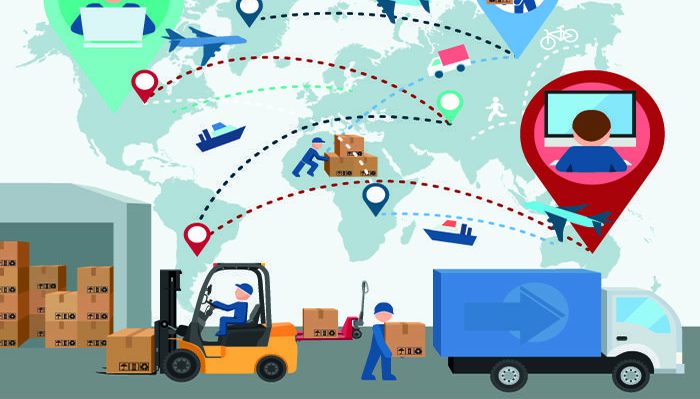Next-Gen Tech Will Benefit SCM Market, Report Finds
Aug 22, 2019 • News • frost & sullivan • service supply chain • supply chain • report • Parts Pricing and Logistics
Technologies such as AI, ML, blockchain and robotics will drive multiple growth opportunities in Supply Chain Market, research suggests.
Frost & Sullivan’s latest analysis, Growth Opportunities in the Internet of Things-enabled Supply Chain Management Market, Forecast to 2024, reveals that end-to-end visibility, predictive analysis, transparency, and real-time insights are some of the benefits driving the adoption and implementation of Internet of Things (IoT) systems within the supply chain management (SCM) market. The trend toward IoT-enabled SCM is creating a convergence of disparate sets of providers and the rise of a new ecosystem that will have far-reaching benefits to users.
“Current supply chains will be reinvented as IoT-enabled systems allow unprecedented end-to-end visibility, remote tracking, and control,” said Deepali Sathe, Senior Industry Analyst at Frost & Sullivan. “The increase in automation will significantly improve accuracy of predictions and speed of execution.”
The research identifies market drivers and restraints, offers strategic recommendations, and forecasts IoT revenues in the digital supply-chain management sector until 2024. The research also lists a variety of use-case scenarios across the various segments in supply-chain management.
One of the biggest impacts of technology adoption on SCM has been the introduction of new business models. As data siloes diminish, customers can focus on the benefits that can be achieved as a result of improved end-to-end visibility, ability to remotely control devices, and automated processes.
Vendors offering IoT-enabled solutions can tap into new growth opportunities by:
• Focussing on increasing demand for IoT-enabled, multi-function robots and cobots;
• Investing in the development of sensors and tags required for connected devices;
• Offering strong, multi-layered cybersecurity solutions to tackle potential threats;
• Harnessing data using AI and ML technologies to enable solutions such as chatbots or smart home speakers;
• Meeting customer preference for XaaS business models such as platforms and sensors.
Frost & Sullivan’s latest analysis, Growth Opportunities in the Internet of Things-enabled Supply Chain Management Market, Forecast to 2024, reveals that end-to-end visibility, predictive analysis, transparency, and real-time insights are some of the benefits driving the adoption and implementation of Internet of Things (IoT) systems within the supply chain management (SCM) market. The trend toward IoT-enabled SCM is creating a convergence of disparate sets of providers and the rise of a new ecosystem that will have far-reaching benefits to users.
“Current supply chains will be reinvented as IoT-enabled systems allow unprecedented end-to-end visibility, remote tracking, and control,” said Deepali Sathe, Senior Industry Analyst at Frost & Sullivan. “The increase in automation will significantly improve accuracy of predictions and speed of execution.”
The research identifies market drivers and restraints, offers strategic recommendations, and forecasts IoT revenues in the digital supply-chain management sector until 2024. The research also lists a variety of use-case scenarios across the various segments in supply-chain management.
One of the biggest impacts of technology adoption on SCM has been the introduction of new business models. As data siloes diminish, customers can focus on the benefits that can be achieved as a result of improved end-to-end visibility, ability to remotely control devices, and automated processes.
Vendors offering IoT-enabled solutions can tap into new growth opportunities by:
• Focussing on increasing demand for IoT-enabled, multi-function robots and cobots;
• Investing in the development of sensors and tags required for connected devices;
• Offering strong, multi-layered cybersecurity solutions to tackle potential threats;
• Harnessing data using AI and ML technologies to enable solutions such as chatbots or smart home speakers;
• Meeting customer preference for XaaS business models such as platforms and sensors.
“Predictive analytics based on artificial intelligence (AI), machine learning (ML), and Big Data Analytics (BDA) will reduce errors and take the guesswork out of planning, forecasting and execution,” noted Adrian Drozd, Research Director at Frost & Sullivan.
“Technologies such as blockchain can create better and faster processes and prevent fraud, while robotics will enhance automation and precision for greater accuracy.”
“Technologies such as blockchain can create better and faster processes and prevent fraud, while robotics will enhance automation and precision for greater accuracy.”





















 Field Service News is published by 1927 Media Ltd, an independent publisher whose sole focus is on the field service sector. As such our entire resources are focused on helping drive the field service sector forwards and aiming to best serve our industry through honest, incisive and innovative media coverage of the global field service sector.
Field Service News is published by 1927 Media Ltd, an independent publisher whose sole focus is on the field service sector. As such our entire resources are focused on helping drive the field service sector forwards and aiming to best serve our industry through honest, incisive and innovative media coverage of the global field service sector.
Leave a Reply